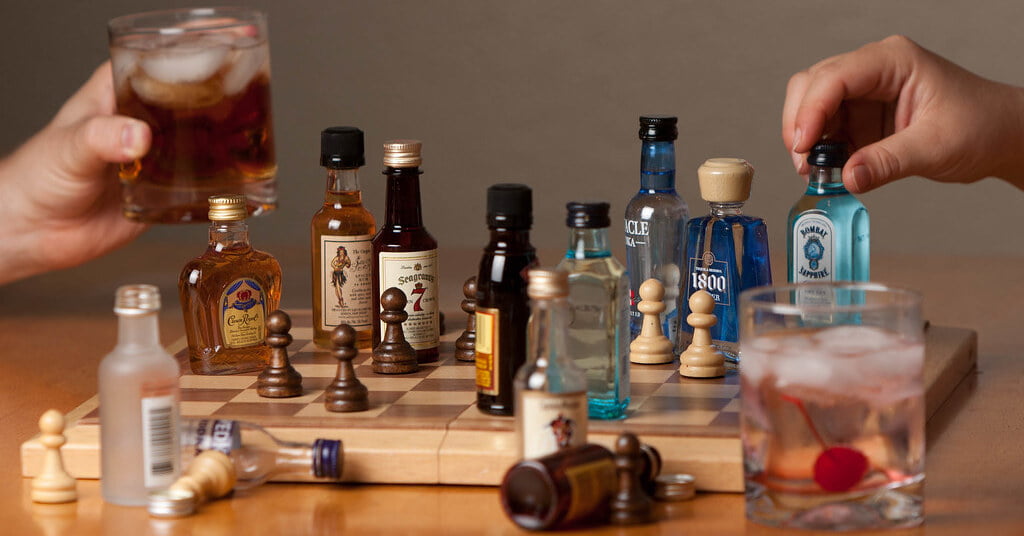According to a number of publications, the world champion skillfully beat his opponent in an unusual game in which the pieces were replaced with containers of alcohol. We have verified the accuracy of such messages.
Usually the participants in the unusual game are called the world champion in 1894–1921, Emanuel Lasker and the Hungarian grandmaster Geza Maroczy, and the organizer is a certain businessman who was fond of chess. Instead of pawns and pieces, either glasses or bottles of different sizes and with different alcoholic drinks were placed on the board. According to the terms of the game, the chess player who took the opponent's piece had to drink the contents. Lasker, who played White, allegedly sacrificed his queen on the third move, which was a 200-gram bottle of whiskey. Maroczy, after its devastation, was unable to continue the fight, and the victory went to Lasker.
Publications about the unusual confrontation are easy to find on social networks - numerous public pages on VKontakte talk about Lasker’s ingenuity, like thematic, which are not related to chess, but have more than a million subscribers (among them "5 interesting facts", "Leprosy", "History in photographs", "The History of Humanity" etc.). Similar posts were popular on Facebook, LiveJournal, on Pikabu and other platforms. Mentions of an unusual confrontation can also be found in books like "1111 Amazing Facts You Didn't Know".
From any serious sources we were able to find a mention of this story in book chess historians Isaac and Vladimir Linder about Lasker. The description of the unusual episode is placed in the “curiosities” section; in the Linders’ account, bottles with various drinks appear instead of figures; the queen was a “substantial bottle of cognac.” The authors do not say from what source they learned about the unusual game between Lasker and Maroczy and whether this source was reliable.
In 2014 this episode interested chess historian Edward Winter. As Winter found out, publications about “alco-chess” appeared back in the 20th century. For example, the unusual confrontation between Lasker and Maroczy is mentioned in the book “The History of Chess,” published in 1972: “They say that Lasker once won a game of “alcoholic chess” by amusingly sacrificing his queen at the very beginning of the game. The queen contained about a quarter of a liter of cognac; the enemy who drank it in one gulp was immediately put out of action.” The author of the book cited this information with reference to B. H. Wood - founder popular British magazine Chess.
In 1959, the same magazine featured a retelling of a BBC radio program on chess, which told a story about Lasker that “may not be exactly true, but describes his character well.” The author claims that one day a wealthy “patron of chess” invited Lasker and Maroczy to dinner and after the meal invited the guests to play. The three of them went to the library, where a huge chessboard with unusual pieces was installed on the floor. The pawns were glasses with liquor, and the other pieces were glasses with other drinks, and their strength corresponded to the strength of the pieces. The queen, in turn, was a large bottle of vodka. The host of the evening invited the guests to compete for a prize of £1000, setting one condition: the contents of the “taken” figure had to be drunk. The development of further events generally coincides with the descriptions in later publications.

© Hulton Archive/Getty Images
According to Winter, this story first became known even earlier, in the late 1930s. Likely primary source historian calls Chess Review editor's column published in the fall of 1938. In this note, the author talks about a lunch with the Belgian and then American chess player George Koltanovsky, “one of the most unreliable chess chroniclers” according to Winter. In Koltanovsky's version, some details differed significantly from later ones: he specified that the action took place in Hungary, while claiming that the chess set was of standard sizes, and the glasses were filled with cognac. After Maroczy was forced to drink the contents of the queen, the game continued for four more moves, while it was later claimed that he immediately abandoned further combat.
Bruce Pandolfini, an American chess player, coach and writer, also agrees with Winter’s conclusions. speaker consultant on the creation of the novel and then the mini-series The Queen's Gambit. In 2009 Pandolfini emphasizedthat there are variations of the popular story involving different chess players, although Lasker and Maroczy are the most common characters. The specialist seriously doubts the veracity of all these versions, and writes about Koltanovsky that he “generally said an incredible number of things.”
Thus, the story of the game of alcoholic chess between Lasker and Maroczy has existed for several decades in the form of a kind of historical anecdote, presented in different publications in several versions. These versions differ in details: different types of drinks and containers, the shape of the chessboard, and the circumstances of the game itself are mentioned. Chess historians could not find reliable evidence of that game, while they characterize the probable primary source as not the most reliable.
Most likely not true
If you find a spelling or grammatical error, please let us know by highlighting the error text and clicking Ctrl+Enter.







